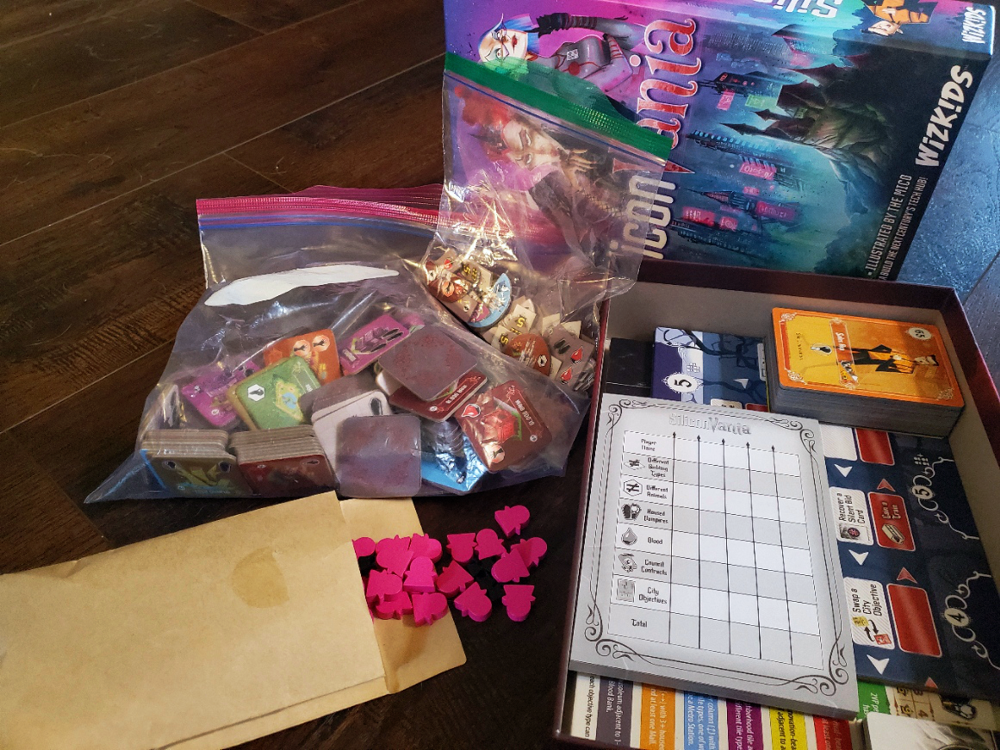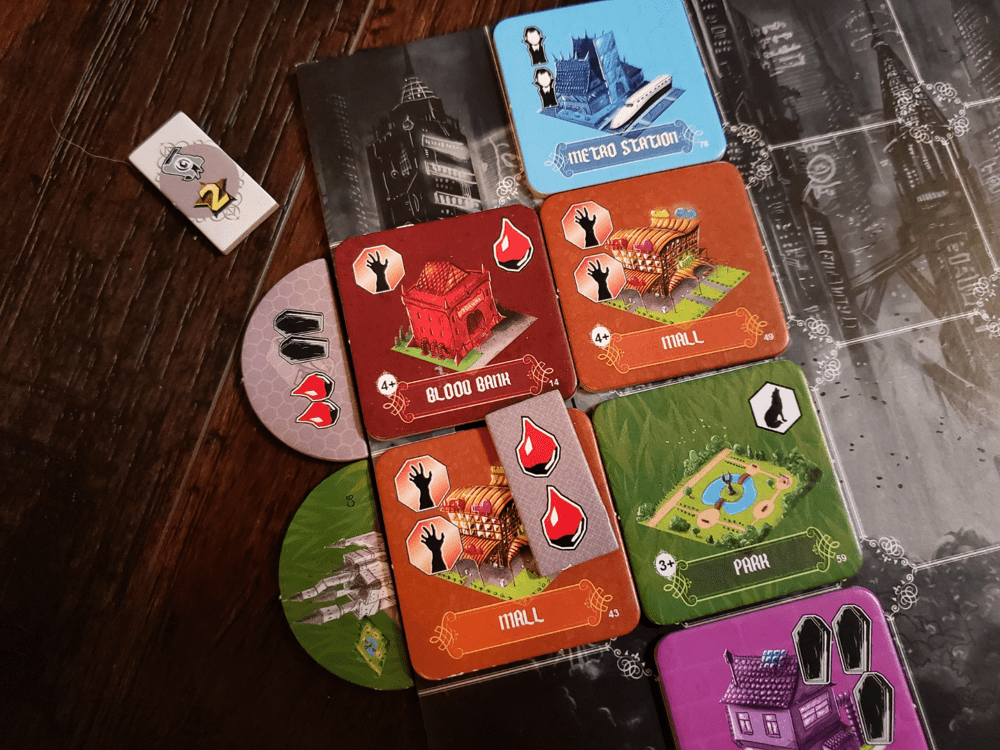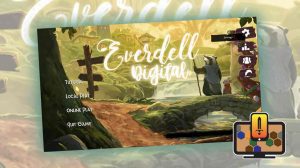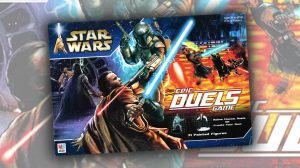Disclosure: Meeple Mountain received a free copy of this product in exchange for an honest, unbiased review. This review is not intended to be an endorsement.
I’m not sure how I feel about starting a written review with a game’s packaging, but alas, that’s where SiliconVania begins. For this title from designer J.B. Howell (Flotilla, Papillon), publisher WizKids has taken a greener approach that both hits and misses from the word go.
First, the hits. Shrink wrap has been replaced by stickers on the box, a change which I honestly prefer all around. Likewise for the cards—O, that every publisher ever would just slap a paper bracelet on their cards! Why haven’t we been doing this from the dawn of time? The wooden components arrive in a paper envelope. I was a bit weirded out at first, but I think I like it. They lay flat and I’ve yet to find random spilled bits in the box.
Next, the one big swing and miss. There are 88 square building tiles to punch along with 35 miscellaneous cardboard “others” that come with no useful packaging. I admit it may have been possible to neatly stack the square tiles into the cardboard insert after every play, but there is just no way 123 cardboard bits are going to stay organized over the long haul. The immediate and obvious solution, one which I doubt I’ll be the last to employ, was ditching the insert in favor of two baggies. So much for green. The best solution would have been some sort of natural bag in the box for the tiles (for both storage and gameplay) and another paper envelope for the smaller cardboard bits. The cost can’t vary that much from a folded insert. With bags, the game fits the box beautifully. It was a miss, but hey, you win some, you lose some.

I do believe the greater concern, though, is with the contents in use.
SiliconVania is a tile-laying game in which players use secret bids and mostly pragmatic (but occasionally shrewd) cardplay to build a city across a 4×4 grid—as vampires. Just as The Hunger once taught us about ordinary vampire appetites, here we find they want to become tech giants—just like the rest of us. After all, they were people once or, in some ways, still are? Vampires are confusing entities. Thankfully, the game is not so confusing…the second time you play.
Across the forest
The turn
There are seven different building tile types in SiliconVania, each with its own preferred arrangement. The hope is to build a utopian grid that keeps every tile type in its proper place, in perfect harmony with every surrounding tile in order to maximize scoring potential. Of course, pesky game mechanics and the other humans at the table do tend to get in the way.

Each player begins with a hand of small Bid cards labeled 1 through 7 and a hand of six standard-sized Specialist cards. Each Specialist card type corresponds to one of the building types. In each of the game’s eight rounds, players select one of both card types. The Bid cards will govern the selection of building tiles while the Specialist cards—at first—will break ties, provide beneficial actions, and govern the selection of additional Specialist cards.

Once cards are simultaneously revealed, players select a pair of building tiles according to their Bids from highest to lowest and place them anywhere in their city grid. Building tiles may have additional icons to immediately gain Vampire meeples or move up on either the Innovation or the Survival tracks. Each Vampire meeple must have a house (coffin) in the city to score. The tracks simply unleash bonus actions and those extraneous cardboard bits. More on those in a moment.
The tiles (and cards)
The tile scoring rules have everything to do with orthogonal (not diagonal) adjacency: Parks near housed Vampires, Survival icons near other Survival icons, Innovation icons away from other Innovation icons, Neighborhoods near 3+ different tile types, Metro stations in columns of four unique tiles, Malls in rows with 3+ housed Vampires, and Mausoleums near Blood Banks.
Oh, and there are bonuses for using all seven tile types. Plus housed Vampires score one point each. And the largest orthogonally connected series of blood droplet icons will score one point each. Plus there are these animal icons on the Parks that score based on diversity. Along the way, there are also these contracts to collect, with a bonus for getting at least three. Got all that? Don’t worry, your first game will be over just as it starts to feel natural and your second game will be far more competitive.
![]()
Having discarded the Bid cards, players resolve their Specialists in number order (they are numbered uniquely from 1 to 70) from highest to lowest. The bottom of the cards grant things like Vampire meeples, track movement, Antiquities that add helpful icons to tiles, and cat & hound meeples that function mostly like Vampires but also like Park animals. Several cards allow for the trade of a single tile with a pool of exchange tiles. Once all that happens, players take a new Specialist card for their hand.
(I’m tossing all these rules out in rapid succession with my tongue in my cheek. There are a lot of convoluted rules—I’m not even done yet!—that are nearly impossible to process the first go-round. Thankfully they are all rather simple rules that make sense for that more important second game. Please don’t read the rapid barrage as total disappointment.)
The (other) turn
Starting in the fourth round of eight, one additional step takes place that makes the game infinitely more interesting. After completing all the actions, players then lay one card from their hand as a declaration of intent. Remember that each card corresponds to a building tile type. These cards—in this step referred to as City objectives—become public declarations of one way the player’s city will score at the end of the game. To this point all tile placement has been speculative. By declaring the objectives, SiliconVania gets real. Now everyone knows exactly how everyone else wants to score their points.
To compound the interest, players may lay up to three copies of a card type over the last five rounds. So if Suzie lays a Doctor card, the red one that corresponds to those Survival track icons, everyone else now knows Suzie will be looking for those icons in the Bid to maximize her tile score. If Suzie is so bold as to lay another Doctor in round five, each card will score the points, meaning she really wants those icons. These cards are expressions of desire and they are where the puzzle takes on personality.
Now every Bid and every Specialist card becomes a more concrete possibility. I might grab a Specialist because of its high number, its ability, or its usefulness as a scoring card. Oh, and I might grab one because Suzie really obviously wants it for her city.
The other caveat here is that hand size begins to dwindle with the fourth round. To this point there has been a steady diet of six cards. In rounds 4 through 8, players use two cards but only replenish one. When the game ends only one card remains in hand, so this downhill endgame must be managed efficiently. The smaller Bid cards are also single-use, but there are several opportunities to reclaim a used Bid, making that aspect less tense than the Specialists.

I should add that there are also Train and Castle tokens (the extraneous cardboard bits) that expand the grid. As rewards of the Survival and Innovation tracks, these half-moon tiles can be placed around two sides of the board as additives to a column or row. Castles work like building tiles, with one of each color available as first-come, first-serve gifts. Trains add two blood droplets and two coffins, often welcome additions to some of the game’s scoring features.
When the game ends, each player has a grid of sixteen tiles and five scoring cards. After scoring tile variety, Vampires, Blood, Contracts, and Animals, the saved cards provide the bulk of the score in determining a winner.
Flint…butterfly?
Two of my favorite games are Warsaw: City of Ruins and Sagrada. Both consist of populating a grid under increasingly stringent tensions according to a series of patterned rules. I get all of those vibes from SiliconVania. I can’t say the vampires are better than either, but I do enjoy the little bloodsuckers. They induce enough light stress to make me want to keep them around.
The bidding system is interesting as an alternative to tile/dice drafting. Bidding on two bundled tiles is fascinating because the pairs are seldom ideal, forcing constant adaptation and aggravation. The two-player game is slightly different, and less wrenching, as the winning player grabs two tiles of choice, leaving the opposition with the leftovers. This makes the bid supremely important, but not necessarily more interesting. I’ve enjoyed participating in the agony of wanting while facing despair. Topping off the mechanism, the inclusion of the Specialists in the process adds a clever wrinkle.
I whole-heartedly celebrate the Specialists; this is where the art from The Mico really shines. I wish each card within each type was unique, but I understand budgets are a thing and 70 unique cards are probably expensive. I also love the quadruple-use of each card: as tie-breaker, as ability, as card selection, and as scoring. And if spite draws are your game, there’s a viable fifth dimension. In an eight round game, it’s likely your motives will touch every avenue. The Specialists give SiliconVania more soul than every other feature combined.

I bristle at the name of the game as some will, but I understand. Trans (across/beyond/through) sylvania (forest, woods) with a pun on Silicon Valley becomes SiliconVania. It works in the same way Castlevania works. But it all gets etymologically weird when you think that, upon discovery, Silicon was slightly misnamed for the Latin silex (flint/hard stone) and vania is Greek for…butterfly? It’s probably best to just move along.
I mentioned earlier that the rules come at you like buckshot, and I meant it. As a teaching method, I would recommend setting up, playing a round or three, and then starting over. Until the tiles start to take shape and the game’s rhythms settle down, folks will be dazed and confused. Thankfully, a full game rarely exceeds an hour so this method really won’t add tons of time. Even three players can finish eight rounds in under 45 minutes. The player board has all of the scoring conditions printed along the right side, which was a necessary and good choice by the development team.
One reason I’ll go on loving games like Warsaw and Sagrada more than the vampires is their base simplicity. As a tile game alone, I’m not sure SiliconVania would bring enough heft, so the extra bits and tiles feel necessary despite the tangles they introduce to the learning curve. Warsaw innovates by introducing war to devastate player efforts. Sagrada wins through bare-boned beauty and the necessity of adjacent construction. The breadth of materials that go into fleshing out this tech-vamp puzzle keeps it shy of the brilliancy prize, but it in no way detracts from its status as a decent play.
As a family game, the theme is a bit dark, but the presentation is more quirky than creepy. Our ten-year-old fully grasps the rules and rhythms even if he can’t beat mom and dad. The artwork and strangeness adds a layer of appeal for the tweens and teens. The puzzle and the good company keeps the parents at the table. Mechanically, the game brings everyone back to the center frequently enough to keep folks from feeling they are playing alone. Favorite or not, there really is a lot to enjoy here.
In the grand scheme of things, SiliconVania is not above critique, but I’d say there’s more for celebration than complaint. If you’re into the grid puzzles, the layered bidding system might be enough to warrant giving the techy vampires a try. If it stays in its $30 pocket, I think you’ll get your money’s worth if not much, much more.











Great article Bob! I feel we both landed in the same spots regarding, the first “learning” game and in overall assessment. I’ll have to put this in front of my 9 and 11 year old’s and see if they can grasp as your 10 year old did. Cheers!
Thank you for the kind words! There’s a lot to love in the box. I hope the outing with the family goes well. If the quirky art and colorful bits hold them long enough, there’s a decent amount of gratification that comes from pulling off a solid arrangement.